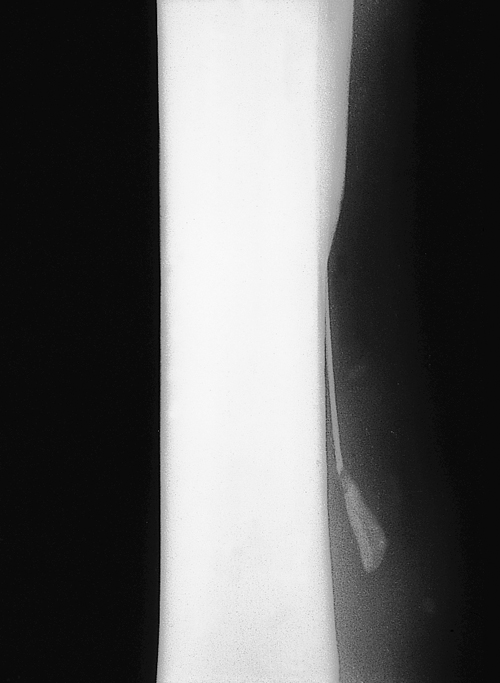Difference between revisions of "Equine Orthopaedics and Rheumatology Q&A 10"
Jump to navigation
Jump to search
Ggaitskell (talk | contribs) (Created page with "{{Template:Manson May}} centre|500px<br> <br /> <br /> <FlashCard questions="4"> |q1=What is your diagnosis? |a1=A ...") |
|||
| (3 intermediate revisions by 2 users not shown) | |||
| Line 1: | Line 1: | ||
{{Template:Manson May}} | {{Template:Manson May}} | ||
| − | [[Image:Equine Orthopaedics and Rheumatology Q&A | + | [[Image:Equine Orthopaedics and Rheumatology Q&A 09.jpg|centre|500px]]<br> |
<br /> | <br /> | ||
| − | |||
<br /> | <br /> | ||
<FlashCard questions="4"> | <FlashCard questions="4"> | ||
| − | |q1=What | + | |q1=What is your diagnosis? |
| − | |a1= | + | |a1=A fracture of the distal part of one of the splint bones. |
| − | |l1= | + | |l1= |
| − | |q2= | + | |q2=Assuming that the injury is not associated with external trauma, how is it likely to have occurred? |
|a2= | |a2= | ||
| − | + | These fractures are thought to occur as a result of stresses placed on the splint bone by the adjacent suspensory ligament. <br><br> | |
| − | |l2= | + | It has been suggested that, during hard exercise, the suspensory ligament snaps back against the relatively fixed small metacarpal or metatarsal bones, causing the distal part of the bone to fracture. |
| − | |q3=What | + | |l2= |
| − | |a3=The | + | |q3=What associated structure may have been injured? |
| − | + | |a3= The adjacent suspensory ligament branch may have been sprained or even ruptured. | |
| − | |l3= | + | |l3= |
| − | |q4= | + | |q4= If the horse has both problems, which is most likely to cause persistent lameness? |
| − | |a4= | + | |a4= The splint bone fracture is unlikely to heal by bony union, but the fibrous union formed does not usually cause any problems. <br><br> |
| − | |l4= | + | However an associated sprain of a branch of the suspensory ligament may well continue to cause lameness. |
| + | |l4= | ||
</FlashCard> | </FlashCard> | ||
{{#tag:imagemap|Image:Next Question.png{{!}}center{{!}}200px | {{#tag:imagemap|Image:Next Question.png{{!}}center{{!}}200px | ||
| − | rect 0 0 860 850 [[Equine Orthopaedics and Rheumatology Q&A | + | rect 0 0 860 850 [[Equine Orthopaedics and Rheumatology Q&A 10|Next question]] |
desc none}} | desc none}} | ||
[[Category:Equine Orthopaedics and Rheumatology Q&A]] | [[Category:Equine Orthopaedics and Rheumatology Q&A]] | ||
Revision as of 10:55, 27 May 2011
| This question was provided by Manson Publishing as part of the OVAL Project. See more Equine Orthopaedic and Rheumatological questions |
| Question | Answer | Article | |
| What is your diagnosis? | A fracture of the distal part of one of the splint bones.
|
[[|Link to Article]] | |
| Assuming that the injury is not associated with external trauma, how is it likely to have occurred? | These fractures are thought to occur as a result of stresses placed on the splint bone by the adjacent suspensory ligament. |
[[|Link to Article]] | |
| What associated structure may have been injured? | The adjacent suspensory ligament branch may have been sprained or even ruptured.
|
[[|Link to Article]] | |
| If the horse has both problems, which is most likely to cause persistent lameness? | The splint bone fracture is unlikely to heal by bony union, but the fibrous union formed does not usually cause any problems. However an associated sprain of a branch of the suspensory ligament may well continue to cause lameness. |
[[|Link to Article]] | |
